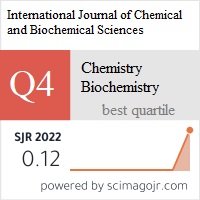International Journal of Chemical and Biochemical Sciences (ISSN 2226-9614)[/vc_column_text][/vc_column][/vc_row]
VOLUME 25(19) (2024)
Evaluating Polycyclic Aromatic Hydrocarbon Levels and Toxic Impact of Hairdressing Salon Effluent on Soil Nitrifying Bacteria
Udochukwu Ugueri1*, Nlemchukwu B.N.C2, Echeta Maryrose Ogechi 1, Iheme Patricia Odichinaka3, Anunihu Chinonso L2, Igiri Vivian Chika1
1Microbiology Department, University of Agriculture and Environmental Sciences Umuagwo, Imo State, Nigeria.
2Chemistry Department, University of Agriculture and Environmental Sciences Umuagwo, Imo State, Nigeria.
3Biology Department, University of Agriculture and Environmental Sciences Umuagwo, Imo State, Nigeria.
Abstract
The recent dramatic increase in the amount of toxic organic waste generation from salons has necessitated researchers to understand the composition of the effluent and its impact on ecosystem functioning. This research focused on the assessment of polycyclic aromatic hydrocarbon (PAH) levels and toxic impact of hairdressing salon effluent on soil nitrifying bacteria. Hair dressing salon effluent obtained from different hair dressing salons in Umuagwo village, Imo state was amended to loamy soil sample in a 25liter Jerrican. After 30 days of pollution, four soil sample categories: Topsoil (0-5cm), Midsoil (12-17cm) and Subsoil (25-28cm) depths, and a non-polluted soil sample, which served as the control, were collected. The PAH contents were determined as well as the microbial load. Further, Nitrobacter sp. and Nitrosomonas sp. were isolated and used to carryout nitrifying bacterial toxicity analysis. The results show that the following PAHs were present in the sample: 51.03ng/g Biphenyl, 15.01ng/g Benzo[a]pyrene, 31.32ng/g Anthracene, 6.42ng/g Phenanthrene and 5.02ng/g Naphthalene. Coronene and Fluorene were below the limits of detection. However, only 1.90ng/g of Biphenyl was detected in the control garden soil. The total heterotrophic bacteria count in the composted soil had counts ranging from 1.0 x 104±1.10 to 2.0 x 104±2.10cfu/g while the control soil sample had higher counts ranging from 2.0 x 104±0.20 to 4.0 x104±0.11cfu/g. The toxicity analysis showed a decline in the heterotrophic bacterial count and both of the nitrifying bacteria were affected in the same manner. The results implies that a constant release of hairdressing salon effluent into the soil poses serious threat to the growth and activities of nitrifying bacterial in the soil. This can affect ecosystem function by reducing soil fertility and crop yield.
Keywords: Nitrifying Bacteria, Hairdressing Salon Effluent, Polycyclic Aromatic Hydrocarbon, Toxicity
Full length article – PDF *Corresponding Author, e-mail: rev.dr.ud@gmail.com Doi # https://doi.org/10.62877/79-IJCBS-24-25-19-79
International Scientific Organization- Atom to Universe
Journals
- International Scientific Organization
- International Journal of Chemical and Biochemical Sciences (IJCBS)
- Volume 27 (2025)
- Volume 26 (2024)
- Volume 25 (2024)
- Volume 24 (2023)
- Volume 23 (2023)
- Volume 22 (2022)
- Volume 21 (2022)
- Volume 20 (2021)
- Volume 19 (2021)
- Volume 18 (2020)
- Volume 17 (2020)
- Volume 16 (2019)
- Volume 15 (2019)
- Volume 10 (2016)
- Volume 14 (2018)
- Volume 13 (2018)
- Volume 12 (2017)
- Volume 11 (2017)
- Volume 9 (2016)
- Volume 8 (2015)
- Volume 7 (2015)
- Volume 6 (2014)
- Volume 5 (2014)
- Volume 4 (2013)
- Volume 3 (2013)
- Volume 2 (2012)
- Volume 1 (2012)
- Store
- Cart
- Account


